



Tales from the classroom is a special blog series where I share research and articles I produce in my DBA (Doctorate in Business Administration) program.


The COVID-19 pandemic has caused significant disruptions in the global supply chain, affecting various industries worldwide. Some of the main challenges that companies are currently facing in maintaining their supply chains amidst the pandemic include the following:
Supply Chain Disruptions. The pandemic has led to disruptions in the supply chain due to lockdowns, travel restrictions, and factory closures. This has resulted in delays in the delivery of raw materials and components, impacting production schedules and inventory levels.
One global company that was impacted by this was McDonald’s. In 2021 to 2022, McDonald’s could not sufficiently supply French fries worldwide. This issue was discussed in mainstream media worldwide, include the Philippines, Japan, and Australia, among many other countries. This was eventually resolved when supply chains opened up and moved to regular operations.
Demand Fluctuations. The pandemic caused fluctuation in demand for certain products, leading to challenges in forecasting and inventory management. Companies are struggling to adjust their production levels to meet changing demand patterns.
At the height of the pandemic, there was a huge demand for rubbing alcohol, disposable masks, and even toilet paper. Manufacturers had a difficult time planning out production and distribution because of the many restrictions. And as the restrictions of the pandemic slowly loosened, demand for these materials also changed, impacting forecasts and inventory management.
Transportation and Logistics Issues. The pandemic has disrupted transportation and logistics networks, leading to delays in the delivery of goods. This has resulted in increased transportation costs and challenges in managing inventory levels.
Transportation and logistics are crucial in effective and efficient inventory management. I remember during the early months of the pandemic, many fast food chains were selling their inventory of frozen meats, such as Jollibee, McDonald’s, and Mang Inasal. Not only did selling off their inventory helped them with cash flow, it also helped them sell these frozen meats that had expiry dates. With branches closed and with limited ability to transport goods, it was the best solution at that time.
Labor Shortages. The pandemic led to labor shortages due to illness, quarantine measures, and travel restrictions. This has impacted production capacity and led to challenges in maintaining workforce safety.
Financial Constraints. The pandemic has caused financial constrains for many companies, leading to challenges in managing cash flow and accessing capital for investment in supply chain resilience.
The most resilient and successful transportation and logistics companies are those with deep pockets because of the nature of the business. You need good cash flow to ensure that goods are transported. This is something I learned from my in-laws. And so the businesses that continue to operate today in the supply chain industry are those with a very good handle on their finances and/or have very deep pockets to withstand the challenges brought by the pandemic.
The challenges above affect different aspects of companies’ operations in the following ways:
Sourcing. Companies are facing challenges in sourcing raw materials and components due to disruptions in the supply chain. This has led to delays in production and increased costs.
Production. The pandemic has disrupted production schedules due to labor shortages and supply chain disruptions. This has led to challenges in meeting customer demand and managing inventory levels.
I remember during the pandemic that crowdfunding sites such as Kickstarter and Indiegogo release statements to their followers, project owners, and campaign backers to expect long delays in the delivery of the campaign rewards. Many projects typically experience delays, but the pandemic made these delays much, much worse as China was experiencing the brunt of the effects of the pandemic.
Distribution. Transportation and logistics issues have led to delays in the delivery of goods, impacting distribution schedules and increasing transportation costs.
I remember ordering books from the Big Bag Wolf during the pandemic. It took about 3 months before my books were delivered. The original promise was a month, but there were significant delays.
The pandemic has created significant disruptions in the global supply chain, leading to challenges in maintaining supply chain operations. Companies are facing challenges in sourcing, production, and distribution due to disruptions in the supply chain, demand fluctuations, transportation and logistics issues, labor shortages, and financial constraints.
Tales from the classroom is a special blog series where I share research and articles I produce in my DBA (Doctorate in Business Administration) program.

The discussion on refugees and migration is a discussion of the allocation of resources. The most significant source of tension in the discourse about migration and asylum is that migrants and refugees are seen as competitions of the host nation’s resources.
The difference with refugees and legal migrants is that the latter move to their host countries with some assets and often with an economic and social integration plan, while many refugees, because of their circumstances, often arrive with no plan and only the clothes on their backs.
For most host countries, the immediate need in the initial period when refugees arrive is to deliver short-term basic needs: food, temporary shelter, and clothing. These efforts require large amounts of resources. However, they also need to provide for their long-term needs and preparing them to integrate into society, which requires an even more massive effort. When you receive refugees, you are essentially managing the nation’s resources, making sure to balance the needs of the citizens of the nation and the needs of refugees.
When war broke out in Syria and through the Ukraine war, many refugees started flocking to Greece. Between 2016-2020, Greece received 3.38 billion euro in an EU support package. Yet, despite support, there are still claims of poor access to resources. Even with overhauls, Greece continues to keep asylum-seekers in refugee camps that struggle to provide accommodations and healthcare (Emmanouilidou et al, 2023).
Refugee movement in Greece is limited, which means they are not integrated into society. From an economic perspective, refugees represent a pool of untapped human resources. There are labor shortages in the European Union, United States, Canada, and Australia. Typically, the short-term solution is to increase the intake of migrants to take up the labor gaps. There’s a reason why economies see migration as one of the drivers for growth—migrants are human resources.
In the long-term, immigration policies shape the cultural fabric of a nation. For example, the United States is a nation built by immigrants. Discrimination and racism typically exist because of concerns that migrants take away resources and opportunities away from citizens, including access to schools and jobs. However, Americans also recognize the value of migration because migrants take on work that many citizens won’t do. Most migrants, however, integrate into American society, accepting dual identities and identify as Asian-American, Filipino-American, etc.
In Japan, a nation known for its cohesive culture, non-Japanese are seen as guests and are treated as so. Should economic conditions worsen, the sentiment is that Japanese should be prioritized in the access to much needed resources. Foreigners are not entitled to Japanese sources. There are also many barriers to integration, language being one of the most significant barriers.
France follows similarly to Japan, although they are more open to migrants than the Japanese. The key difference is that the French expect migrants to fully integrate into French society. They are no longer Algerians, Moroccans, or Tunisians—they are French. Integration often implies leaving behind their home country cultural identity in favor of the French cultural identity (Safi, 2008).
What do the examples of cultural integration in the United States, Japan, and France tell us? There is a diversity of opinion on what it means to integrate into society. Some societies celebrate diversity, which is seen more predominantly in the United States. Some societies are not as welcoming to cultural diversity, such as France and Japan. Is it necessarily bad if a society is not as open to cultural diversity?
If we compare the United States with Japan, they have contradicting sentiments on cultural diversity. Yet they are both innovative economies. It begs the question, is it cultural diversity that leads to innovation, or is it a specific aspect of culture that leads to innovation?
Perhaps the better question is, what does a society give up when they close themselves off from cultural diversity? A study on cultural diversity in London found that cultural diversity was an economic strength for the city, leading businesses to enjoy improved processes and products (Lee and Nathan, 2010).
Furthermore, it’s a basic human right to participate in cultural life, especially one that ties into a person’s identity. Policymakers need to take into consideration that culture is a basic human right, and that policies need to take this into account. There are economic and political advantages to culture diversity, and we can only take advantage of these if we recognize diversity.
Sources:
Constant, A. F., & Zimmermann, K. F. (2016). Diaspora economics: new perspectives. International Journal of Manpower, 37(7), 1110-1135.
ECRE (2022, January 21). Greece: Huge Discrepancy Between Reported Rescues and Arrivals Suggests Massive Pushbacks, Billions Spent Do Little for Violations and Mismanagement. European Council of Refugees and Exiles. https://ecre.org/greece-huge-discrepancy-between-reported-rescues-and-arrivals-suggests-massive-pushbacks-billions-spent-do-little-for-violations-and-mismanagement/
Emmanouilidou, L., Stavinoha, L., & Fotiadis, A. (2023, May 11). EU details violations at Greece’s ‘model’ refugee camps. Aljazeera. https://www.aljazeera.com/features/2023/5/11/eu-details-alleged-violations-at-greeces-model-refugee-camps
Lee, N., & Nathan, M. (2010). Knowledge workers, cultural diversity and innovation: evidence from London. International Journal of Knowledge-Based Development, 1(1-2), 53-78. https://doi.org/10.1504/IJKBD.2010.032586
Otake, T. (2021, June 16). Prejudice against immigrants explained in numbers. The University of Tokyo. https://www.u-tokyo.ac.jp/focus/en/features/z0508_00213.html
Safi, M. (2008). The immigrant integration process in France: Inequalities and segmentation. Revue française de sociologie, 49(5), 3-44. https://doi.org/10.3917/rfs.495.0003
Tales from the classroom is a special blog series where I share research and articles I produce in my DBA (Doctorate in Business Administration) program.

The trade tensions between the United States and China have significantly impacted businesses operating in both countries, as well as those with global supply chains interconnected with these two economic powerhouses.
These tensions, characterized by tariffs, trade restrictions, and geopolitical rivalries, have introduced uncertainty and increased costs for businesses, forcing them to adapt their strategies to navigate this challenging global business environment.
One of the countries that is significantly impacted by these tensions is Japan because of the interconnections of these three countries and the characteristic of the supply chain involving goods manufactured and traded in these three geographic entities. Trade policies may shift to help insulate economies from the negative impact.
For example, Japanese companies that cooperate with US sanctions against China may also be subject to sanctions by China as many Japanese companies in the semiconductor industry do business with both China and US, forcing them to choose between the two (Kwan, 2023). For example, a Japanese company operates and manufactures goods in China. The US imports these Japanese products that are built in China, and because they are built in China, the US will impose import tariffs. The same holds true for Japanese companies that operate and manufacture goods and services in the United States. When China imports from Japanese firms operating in the US, they also may impose additional tariffs. The sanctions effectively remove any competitive advantage these Japanese firms may have benefited from before the trade tensions.
In response to the growing China-US tensions, Japan passed the Economic Security Promotion Act in 2022 to help mitigate the effects of the tensions. As a result, Japanese firms are being encourage to relocate production bases from China to ASEAN and even Japan (Kwan, 2023). This is an example of supply chain diversification (if relocating to ASEAN) and localization of production (if relocating back to Japan), which are mitigating strategies.
Furthermore, because of the national security dimensions of the China-US tensions, Japan also revised the Foreign Exchange and Foreign Trade Act to strengthen restrictions on foreign capital investment in key industries, which includes arms, aircraft, space-related, nuclear, power-related, cyber-security-related, electric power, gas, telecommunications, water supply, railroads, and petroleum. The goals is to discourage foreign takeover of these core industries, whether American but more specifically Chinese investors.
Nevertheless, there are economies that are poised to benefit from the US-China trade tensions, such as India. Jeanette mentioned Apple Inc. In 2023, Apple release their official supplier list, demonstrating shifts in their supply chain preferences (Jiang, 2023)—another example of supply chain diversification. Apple added five new suppliers, but cut out eight suppliers from China. They also moved production bases to India, rising to a total of 14 bases from 2021’s 11.
If we follow the sentiment of the Bangko Sentral ng Pilipinas (BSP) Governor Benjamin Diokno, the Philippines has the potential to benefit from US-China trade tensions. This is because the Philippines has a low exposure to products targeted directly by US tariff actions against the Philippines (Villanueva, 2020). It is worth noting that China is the Philippines’ largest supplier of imported goods, while the US is the fourth largest. On the other hand, Hong Kong is our largest export partner, followed by the US, while China is fourth (Philippine Statistics Authority, 2024).
Nevertheless, there is truly no winner in a protectionist approach to trade. To quote Jeffrey Sachs (2019), “he hardline approach – to be pursued through protectionist trade policies and aggressive technology policies — would prove disastrous, weakening the world economy and creating a self-fulfilling grave risk of future conflict.” If we follow classical economic principles, open trade is a positive-sum game, where all trade partners benefit the more we trade with each other. This is a sentiment shared by Adam Smith, the father of economics. The benefits come from leveraging on competitive advantages and the efficient use of resources.
Sources:
Jiang, B. (2023, May 25). China’s Apple loss is India’s gain, as 2022 supplier list shows shift in supply chain preferences. South China Morning Post. https://www.scmp.com/tech/big-tech/article/3221814/chinas-apple-loss-indias-gain-2022-supplier-list-shows-shift-supply-chain-preferences
Kwan, C.H. (2023, August 25). Decoupling proceeding amid lingering U.S.-China tensions—Rising Concerns about the Impact on Japanese Companies. Reiti. https://www.rieti.go.jp/en/china/23051601.html
Philippine Statistics Authority (2024, January 26). Highlights of the Philippine Export and Import Statistics December 2023 (Preliminary). https://psa.gov.ph/statistics/export-import/monthly
Sachs, J. D. (2019). Will America create a cold war with China. China Economic Journal, 12(2), 100-108. https://doi.org/10.1080/17538963.2019.1601811
Villanueva, J. (2020, May 23). PH to benefit from US-China trade tension: Diokno. Philippine News Agency. https://www.pna.gov.ph/articles/1103764
Tales from the classroom is a special blog series where I share research and articles I produce in my DBA (Doctorate in Business Administration) program.

I have been working remotely as a freelance researcher for about 15 years. Working freelance and remotely affords me flexibility and control over how, where, and how I work. The issue with remote work typically revolves around the question of productivity and motivation. What I have discovered is that I can work productively everywhere, so long as I am motivated to do the work. My motivation to work comes from within—it comes from loving what I do. I have the privilege of choosing what I work on and who I work with—this is motivating to me. I was optimistic about the future of work and how many will transition to remote work.
At the tail end of the pandemic, I was surprised when many did not share my sentiments about remote work. Many say that it is isolating. Many executives say that it reduces productivity and even demotivating.
I disagree with this assertion, particularly if we subscribe to the self-determination theory. The theory posits that people are intrinsically motivated to work when their psychological needs for autonomy, competence, and belongingness. Autonomy means having the choice and control over what, when, where, and how you work. Competence is having what you need to succeed. Belongingness is having connectedness, that feeling of being part of something. How I have been working (freelance and remotely) for years addresses these needs, and this is why I continue to be productive and motivated.
Remote work supports autonomy. Remote work affords workers flexibility—the choice and control over what, where, when, and how they work. However, I do understand why some may think that remote work may be disadvantageous because it may undermine competence and belongingness. Remote work can be isolating, and some workers feel that they don’t receive the information or resources they need to achieve their goals or accomplish tasks. It leaves them feeling helpless and without direction. Rigidity and micromanagement, which are poor practices that have trickled into remote work from traditional office work, can also undermine autonomy.
The article provides relevant and feasible strategies to help address the issued above. While the primary issue that the article addressed was the issue of creating work-life balance that allows workers to be productive despite of distractions, these strategies also enhance or contribute to enhancing worker autonomy, competence, and belongingness. For example, routines simplify decision-making. It takes away the need to make decisions on the minute details—such as when should I begin work or where should I work or what should I work on at specific times of the day—and focuses my time and energy on the consequential decisions of the day. This strategy contributes to autonomy because it makes me feel in control and have a choice over how I use my resources (time and energy) for the day. And in doing so, it helps me feel competent because it allows me to demonstrate good time and energy management. Furthermore, it also supports belongingness. It allows me to become present in conversations and meetings because I know that I have allocated enough time and energy for the things that I need to accomplish.
In connection with the first strategy, I particularly appreciate the advice on planning for structure and flexibility. I firmly subscribe to the belief that boundaries enable freedom. In the same logic, structure enables flexibility. My routines enable me to choose what, when, where, and how I work. It also allows me to feel competence because I am able to demonstrate good resource management.
One should caution, however, that the goal is to find a good balance between structure and flexibility. The rigidity of schedules and routines, specifically those that do not allow one to pivot or change, undermines the advantages and benefits of flexibility. The reason why I decided to work remotely is because I want to be there for my family while allowing me to work on things that matter to me. Routines and structure scaffold my days—following the routine are a means to an end. And we should caution on determining success based on how closely we follow structure and routines, particularly on days that call for more flexibility. I found out through years of working that I can be successful in remote work if and when we focus on addressing our needs for autonomy, competence, and belongingness. The article provides feasible and relevant strategies that allows me to do so.
Remote work has allowed me to demonstrate the skills that I am most proud of developing through the years: creativity, problem-solving, and communication skills. I thrive in remote working and learning environments. In fact, I could say that I love this set up because it allows me to keep a balance in work and life. Most importantly, it allows me to have the life that I want, while supporting my needs for autonomy, competence, and belongingness.
What makes it work is communication. I understand why some will see remote work as isolating. However, thanks to technology (video conferencing, instant messaging, and work management platforms), it’s easier and much more convenient to reach out to team members remotely. Technology also makes it easier to get the information you need to accomplish work. There are more tools available today that allow us to work anywhere, anytime, while still feeling connected to the people we work with.
However, I also run the risk of being too digitally connected. There are times when I feel that technology makes it easy for me to multitask. This is when I develop time optimism and wrongly think that I can accomplish more than I can. This is where I believe the strategies in the article help me strike a balance. Routines and structure allow me to allocate my time and energy better. Zeitgebers, specifically, provide signals on when I should transition from work to family—and vice versa. These allow me to be present with my team, my students, and my family. Routines and structure enable me to be flexible and present, which in turn supports my need for autonomy, competence, and belongingness.
While I fully support remote work and remote learning, I find myself pondering about the suitability of remote learning in the college context. I recognize the value of remote learning because it is inclusive and allows more learners to participate in the process. Distance from school is no longer an issue in remote learning, although access to technology is. It allows for flexibility and can be cost efficient for some students—they don’t need to spend for transportation. However, I feel that there are some aspects of teaching and learning that is better achieved in person.
For some context, I teach undergraduate students and have observed that they prefer in-person classes over Zoom lectures. I decided to run a survey to understand their preferences. What I learned are these:
My argument on the value of in-person learning, particularly in undergraduate learning, stems from the need for belongingness. Learning is a social process. For young college students, it is very important to learn with peers. Technology cannot replicate the collaboration dynamic present in in-person collaboration.
And so I continue teaching with a compromise between remote and in-person learning. to hold in-person lectures and schedule in-person group activities. But I also schedule time for students to accomplish their individual requirements remotely. The issue still goes back to the need for self-determination. We work and learn best when our needs for autonomy, competence, and belongingness are addressed. Just as remote work cannot apply to all fields, there are also aspects of learning that cannot be accomplished or addressed remotely.
As I pondered on the value of remote work, specifically its value in my life, I also cannot help but think about whether others feel the same way or derive the same value as I do.
Is remote work for everyone?
How do we address it when not everyone in the team is built for remote work?
Does everyone understand and possess the necessary skills to succeed working remotely?
If they lack these skills, do they know how to develop or enhance these skills?
Do all managers understand how to support their teams in skills development?
More importantly, do all managers understand and possess the necessary skills to lead a working team remotely?
I am also curious about how effective the strategies cited in the article are.
How much does communication and zeitgebers contribute to achieving remote work goals?
Perhaps, also importantly, are zeitgebers and internal communication tools being abused? Are they being used to micromanage remote workers? Do they result in more unnecessary meetings, for example? Lastly, the assumption on the article is that remote workers work in the same time zone. My remote work experience is that I work with team members located in different time zones. Some of the strategies, specifically zeitgebers, will require further contextualization and adaptation to suit a multizonal team. In this context, what kind of zeitgebers will work? What communication strategies will support a team member’s autonomy, competence, and belongingness? What skills and mindset should managers develop in managing these types of teams?
Tales from the classroom is a special blog series where I share research and articles I produce in my DBA (Doctorate in Business Administration) program.

The key issues I encounter with AI and machine learning typically revolve around abuse of technology, potential job losses, and AI models going rogue. The webinar provides more context on these issues, expounds on how the technology may be misunderstood, and how these issues are being addressed. What I learned was how broad AI is and that there are very many classifications for AI and, equally, very many ways it can be used.
From an educator’s standpoint, I was happy to confirm my belief that there is value in using AI for learning and development, and its contribution goes beyond what we know about ChatGPT. As one of the speakers mentioned, ChatGPT is a very small part of the AI pie and there are many other models being developed to address very specific learning and development needs.
Generative AI models are being used to help train professionals in various fields. I see many advantages in this. First, most trainings involved self-paced learning using multimedia material. While these are helpful, there are many instances when learners have questions that learning materials cannot directly address. Generative AI models that were developed for training provide interaction during the learning process, which helps keep learners engaged. As an educator, I believe that learning does not occur in a vacuum. In fact, I believe that learning is a social activity. While I don’t consider generative AI models as a substitute of collaborative learning, it seems to be an adequate alternative for when independent learning is a requirement.
I was pleasantly surprised that many view generative AI models as a tool that will help humanize work. The webinar explained how AI can help customer contact agents, who are typically expected to provide solutions as quickly as possible while simultaneously processing huge amounts of information within a short period of time. I have made many calls myself to contact centers, typically when I am already irritable and needing an immediate solution. From an agent’s standpoint, they can’t solve problems they don’t understand, which means they spend a good amount of time gathering the relevant information, including verifying customer identification, before they can resolve an issue. As this process takes time, it annoys an already irate customer even more. Having a way to optimize this step will make the agent more efficient. AI can take out the grunt work so that the agent can spend more time providing solutions—the kind of work that truly matters to the customer. Finally, I was pleased to discover that the development of guardrails in AI is an important issue that practitioners in the field are actively working on. That AI will develop sentience is a concern and fear of many, which I attribute to Hollywood films. Nevertheless, I don’t think these fears are misplaced, particularly as some generative AI models do handle and train on personal and sensitive data. One speaker also mentioned that while currently, those in leadership positions seem responsible and act with integrity, there is still the fear that they will be replaced by others who may not act so and may abuse the information or technology to their advantage.
Initially, I was also hesitant about AI and how it may contribute to education. I can understand how ChatGPT may be used as a tool for cheating. However, I cannot help but compare this logic used in the introduction of the Internet and how the Internet could negatively impact learning because it makes things easy for anyone to “copy and paste” information. However, we have also seen how the Internet has aided students by enhancing their learning. The Internet democratized information. I see AI as something that will also democratize information that will benefit those who have limited access to them (i.e., schools and students in rural areas).
I am excited also to learn that there are many who are using generative AI as a tool we can use to take out the pain points of working. Information processing takes time and effort. As humans, we have the limited capacity to remember data instantly. Having something that processes that information in a relevant and usable output may aid in decision-making.
Generative AI was not developed to replace humans, but instead to help us. This is especially true for the kind of work that is built around human interactions, such as customer contact or customer relations. While chatbots have been developed to help manage customer communications, I find that the current iterations continue to be lacking in many aspects. They bare limited information and I often find that the information they relay are often canned or standard and rarely provided in the context that is relevant to me. Many times, the information they relay are no different than the information that I will find in a company’s website, for example. There are even times when I find it cumbersome to use chatbots, because they are often the first line of communication. So instead of being helpful, I find it wasteful communicating with them, because I already know they won’t provide the information or assistance that I need for my issue or problem. This is why I don’t see why the current iterations will replace humans in customer communication.
The discussion helped me understand that there are measures in place to help address the risks of technology abuse and potential job losses. More importantly, I see that they have a long-term, beneficial view of generative AI, particularly on how they can help us in our lives. Like the Internet, AI is a tool. When used properly, it can add value in our learning, our growth, and our lives.
While the subject matter experts have addressed the issue or fears of AI models going rogue, there are still some questions regarding the sufficiency and robustness of existing guardrails.
Do these guardrails really work?
Are they effective and sufficient in achieving their goals?
Are they protecting against the correct risks? Perhaps more importantly, have the developers identified all the risks involved? Is there a body responsible for identifying the risks?
How do we ensure that there is transparency on how AI models are being trained?
What information or data is being used to train them? Are they using private or sensitive information? How do we ensure that data used have the appropriate consent from entities who own them? Furthermore, how do we ensure that the information is only used as intended, and that the generative AI model will not abuse this information?
As a student and researcher, I find that generative AI’s potential in helping me learn. I also see that AI can help me identify where to start with my research, perhaps even guide me towards the right direction. It has helped me create outlines for my research.
However, I have also seen downsides, particularly for ChatGPT. Some information provided by the platform is not always accurate. I have seen reports generated by ChatGPT citing resources that does not exist. As in any research, it’s always important to check sources and triangulate information to ensure their accuracy.
As a teacher, generative AI has challenged me to find ways how to improve learning and enhance student engagement. Information is readily available, and students can easily create prompts in ChatGPT to generate class requirements. However, just as one webinar speaker has mentioned, teachers should learn how to ask probing questions to help gauge whether learning has occurred.
In general, I am excited to learn more about generative AI and its application in both industry and education.
Tales from the classroom is a special blog series where I share research and articles I produce in my DBA (Doctorate in Business Administration) program.
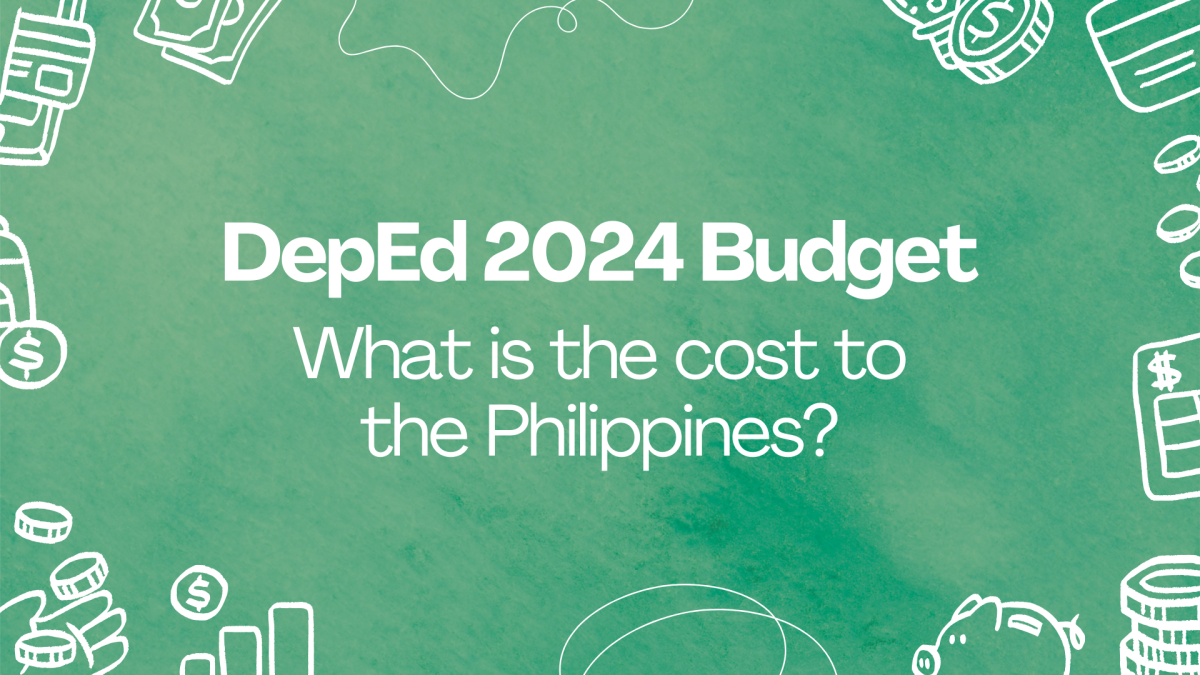
Background
DepEd’s budget received an increase from P633.3 billion in 2022 to P710.6 billion in 2023.
The DepEd, with a 13.2% allocation in the proposed Php5.768 trillion 2024 budget, is second only to the Department of Public Works and Highways (DPWH) with 14.3% share. Only the Office of the Secretary (OSEC) has a minimal budget increase of 5.3%, while all the other agencies under the department have budget cuts (San Miguel, 2023 August 30).
The agencies under the DepEd that are experiencing budget cuts are:
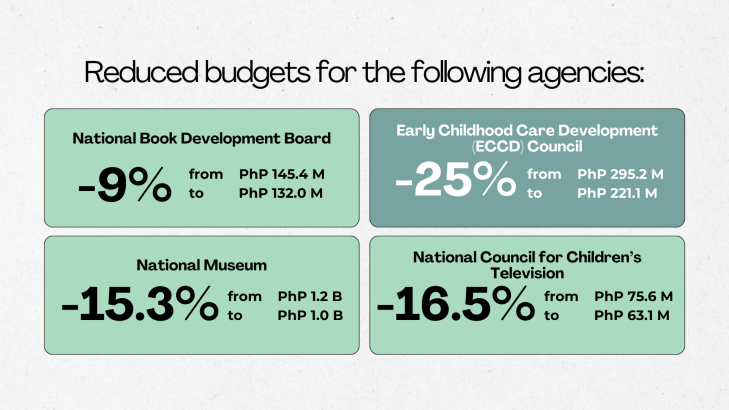
It is particularly problematic to know that the budget of the early education arm of the DepEd will be cut down by a fourth or by PhP74.1 million, while PhP150 million will be allocated to what amounts to discretionary spending.
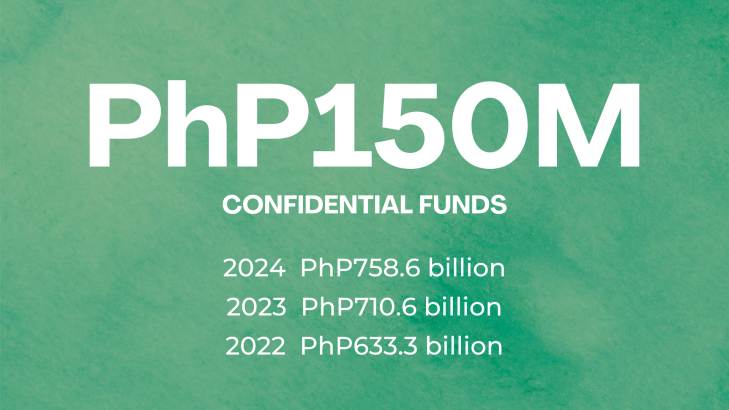
Fortunately, the House of Representatives decided to realign the confidential funds in the proposed 2024 DepEd budget (Crisostomo, 2023 September 30). However, should the PhP150 million be used for security or to solve issues in Philippine education?
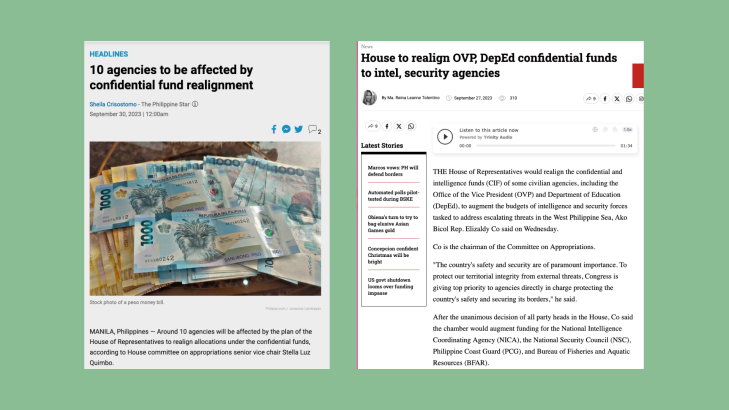
What is problematic in this scenario?
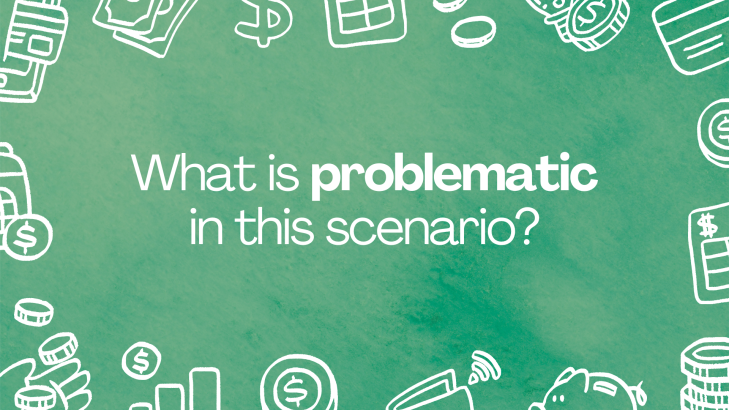
(1) The PhP150 million in confidential funds undermine transparency.
The problem with including an item for confidential funds is that it undermines transparency in the budget process. They are essentially discretionary funds. By their nature, their existence in the DepEd budget also undermines the Constitution because it takes away the House’s ability to scrutinize the budget and determine whether resources are being used or allocated for the most important needs.

Vice President and DepEd Secretary Sara Duterte said that there was “a purpose and need for confidential funds in the Department of Education because basic education was intertwined with national security.” She has also been quoted saying, “For after all, there is security, there is peace.”
I would argue that the correct quote is, “If you want peace, work on justice.” Justice entails transparency and parity, which does not happen when you curtail or undermine systems put in place to ensure their existence. There are also existing departments mandated to address security concerns, particularly the Department of Interior and Local Government (DILG). Why should DepEd address concerns outside of their mandate? Is this an efficient use of their resources?
Furthermore, DepEd, through its secretary, did not fully explain the need for the confidential funds. What needs are these funds addressing? How important are these needs? And do they supersede the pressing needs in the Philippine public education system?
(2) They reduced the budget for important agencies, particularly the Early Childhood Care Development Council (ECCD).
The ECCD Council is a government agency mandated by Republic Act 10410 or the Early Years Act of 2013, as the primary agency implementing the government’s National ECCD System.
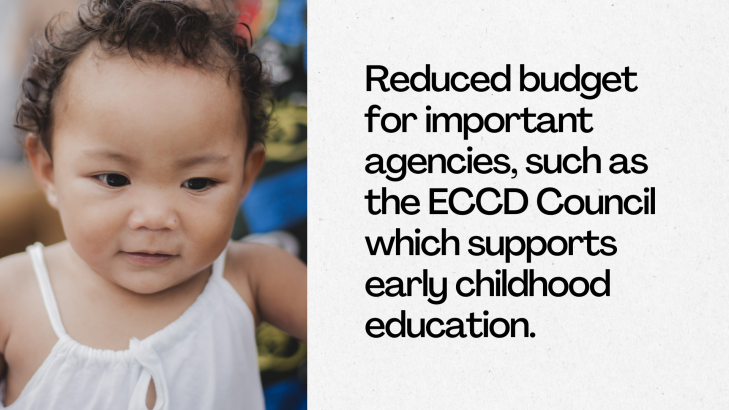
The National ECCD System refers to and covers the full range of health, nutrition, early education, and social services programs and services for children aged 0 to 4 years old. Essentially, it aims to address early childhood education needs through a holistic approach.
The Council is responsible for (1) establishing national standards, (2) developing policies and programs, (3) providing technical assistance and support to ECCD service providers, and (4) monitoring ECCD service benefits and outcomes.
Many studies have demonstrated the value of early childhood education, particularly in learning outcomes (Lunenberg, 2000). Reducing the budget of the ECCD by 25% suggests that early childhood education is not a priority of DepEd.
What is the opportunity cost of the PhP150 million in confidential funds?
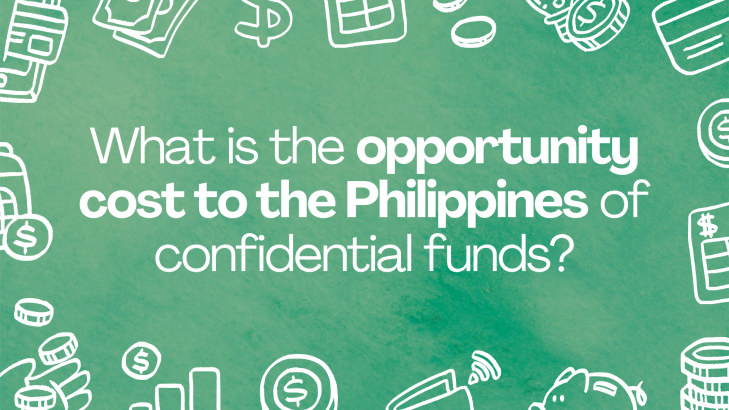
Does the DepEd truly understand the problems facing Philippine education? What problems aren’t the PhP150 million in confidential funds addressing?
In my opinion, the Philippines is facing a severe public education problem that impacts the growth capacity of the Philippines in the long-term. This should be the priority of DepEd.
(1) The Philippines faces severe learning poverty.
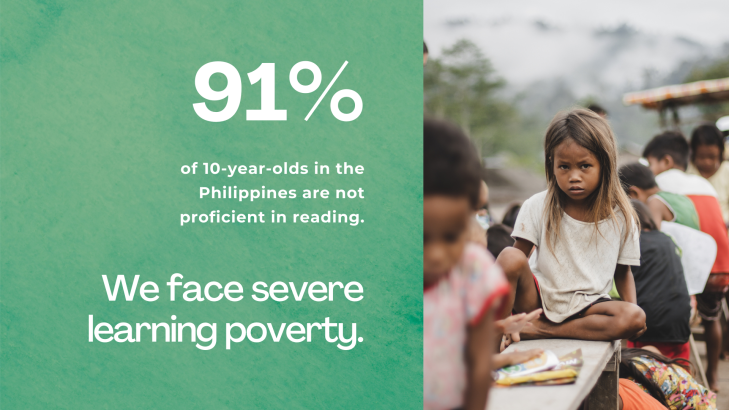
According to the World Bank (2022), there is severe learning poverty in the Philippines: 91% of children in the Philippines at late primary age (10 years old) are not proficient in reading. There are two indicators for learning poverty: (1) learning deprivation and (2) schooling deprivation. In the Philippines, we have both.
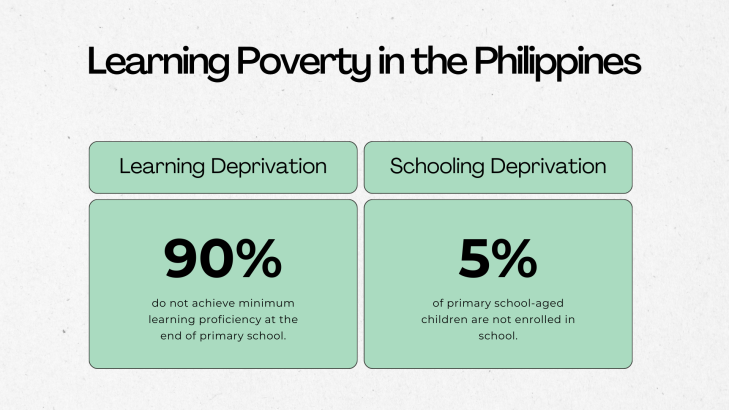
(2) We are not spending enough to educate Filipino children.
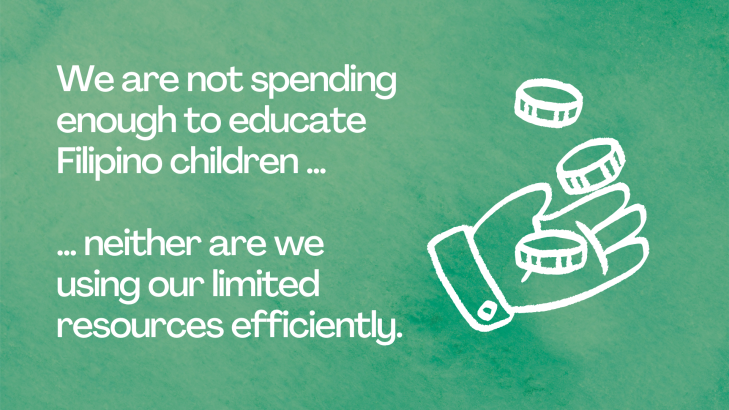
Primary education expenditure per child of primary education age in the Philippines is USD 569 (PPP), which is 83.5% below the average for the East Asia and Pacific region and 29.5% below the average for lower middle income countries (World Bank, 2022).
The approved 2024 Philippine budget is reallocating resources away from early childhood education.
Here lies the problem. Many studies have shown that early education programs have a significant and positive impact on the academic, economic, and social aspects of a person’s life (Lunenburg, 2000). If we are to address the Philippines’ learning poverty today, it would be best to begin by spending for early childhood education.
But will increasing spending alone address learning poverty?
Abrigo (2021) posits that spending alone is not an indication of schooling quality as “some systems may be better at converting education inputs into outputs.” He offers, for example, that “Belarus, and Bosnia and Herzegovina both spend about PPP$50 thousand in cumulative education consumption up to age 15, but their average PISA scores differ by about 70 points.”
Does this apply to us? Unfortunately, this doesn’t seem to be the case if our learning assessments are any indication. This only means that we are not only underspending, but we are also not making efficient use of our limited resources, leading to poor public education quality.
(3) Teachers are part of the reason for the learning gaps.
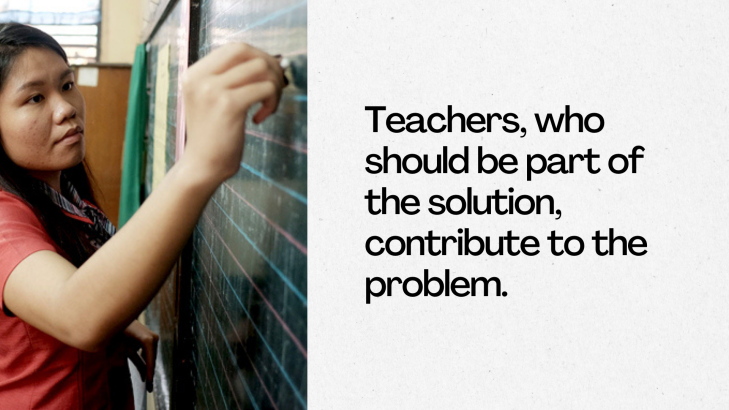
The World Bank claims that quality of teaching, pedagogy, and classroom management are among the significant factors that impact learning outcomes. The Philippines lags behind in these areas. The report furthers that many of the in-service training programs in lagging countries, including the Philippines, lack the crucial elements of effective teacher training programs (Afkar et al, 2023).
Teachers are crucial in addressing learning poverty. Unfortunately, the quality of teacher training programs has been found to contribute to learning poverty.
(4) We have a classroom gap.
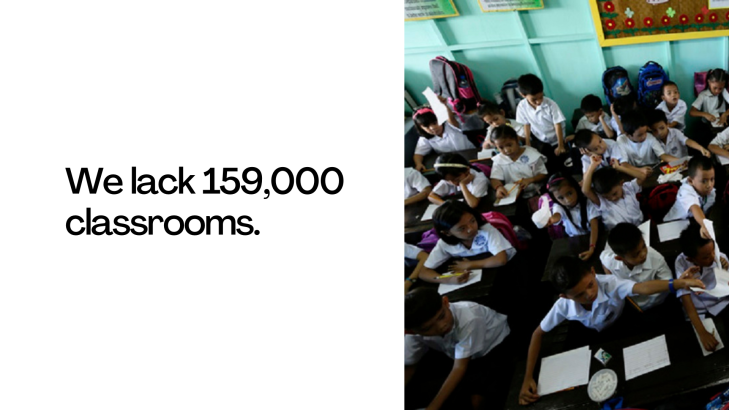
According to DepEd (Tan, 2023), the Philippines require a yearly budget of P100 billion to resolve the classroom shortage by 2030. Having schools and classrooms, particularly in poor communities, is necessary to keep kids in school (Lunenburg, 2000).
Currently, the Philippines lacks 159,000 classrooms.
Poverty is one of the significant reasons why children stop attending school (Fernandez & Abocejo, 2014) and a significant contributor to schooling deprivation. Many children choose to join the labor force to augment household income, while others simply stop attending school because of the costs of doing so, including but not limited to transportation costs. Fernandez and Abocejo (2014) propose that free basic education is not enough, and governments should construct schools close to poor communities to encourage more children to attend.
DepEd estimates that each classroom costs PhP2.5 million to construct. While the figure seems inflated already, the confidential funds could have been used to construct 60 classrooms.
Addressing schooling deprivation requires a holistic approach because poverty is a multi-dimension issue. It is for this reason why the ECCD is mandated to provide early childhood education support with a holistic approach.
(5) The Philippines will suffer in the long term if this is not addressed.
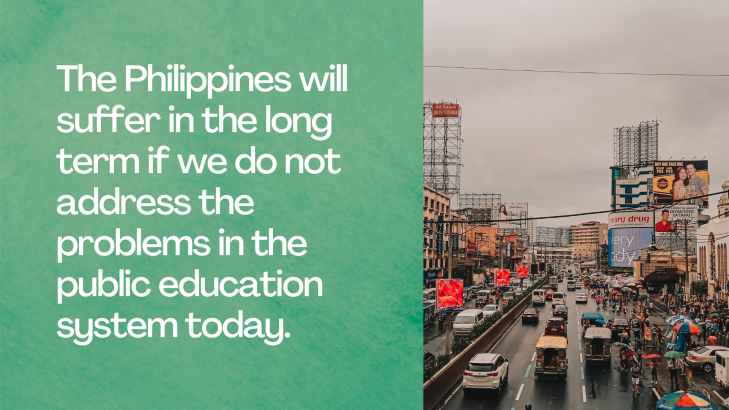
What issues are we currently facing? We have learning poverty in the Philippines. Teachers, who are supposed to help reduce learning poverty, are not only ill-equipped to address the issue, but their poor training contribute to learning poverty. The Philippines also lacks 159,000 classrooms to support public education.
If we don’t address these immediate problems, we are going to run into a labor crisis in the next decade or so, when these children join the workforce.
The Philippine labor force has long been considered as the Philippines’ competitive advantage. We banner our skilled, English-speaking labor force, which has earned us investments in business process outsourcing, among many other industries. However, this competitive advantage is slowly eroding. With Thailand, Indonesia, and even Vietnam (Abrigo, 2021) outspending the Philippines in education, we might soon lag behind our neighbors in Southeast Asia.
Sources:
Abrigo, M. R. M. (2021). If you pay peanuts, you get monkeys? Education spending and schooling quality in the Philippines (No. 2021-27). PIDS Discussion Paper Series. Retrieved from https://pidswebs.pids.gov.ph/CDN/PUBLICATIONS/pidsdps2127.pdf
Afkar, R., Béteille, T., Breeding, M. E., Linden, T., Mason, A. D., Mattoo, A., … & Yarrow, N. (2023). Fixing the Foundation: Teachers and Basic Education in East Asia and Pacific.
Chi, C. (2023, September 22). Learning poverty in the Philippines linked to poor teaching quality – World Bank study. Philippine Star.Retrieved from https://www.philstar.com/headlines/2023/09/22/2298233/learning-poverty-philippines-linked-poor-teaching-quality-world-bank-study
Crisostomo, S. (2023, September 30). 10 agendies to be affected by confidential fund realignment. PhilStar.com. Retrieved from https://www.philstar.com/headlines/2023/09/30/2300086/10-agencies-be-affected-confidential-fund-realignment
Fernandez, R. C. C., & Abocejo, F. T. (2014). Child labor, poverty and school attendance: Evidences from the Philippines by region. CNU Journal of Higher Education, 8(1), 114-127.
Lunenburg, F. C. (2000). Early Childhood Education Programs Can Make a Difference in Academic, Economic, and Social Arenas. Education, 120(3).
Macasero, R. (2023, August 23). Philippine classroom shortage rises to 159,000. Rappler. Retrieved from https://www.rappler.com/nation/deped-report-classroom-shortage-school-year-2023-2024/
Mantaring, J.R. (2023, September 4). DepEd’s PhP758.6-B proposed 2024 budget gets Senate panel nod. CNNPhilippines.com. Retrieved from http://www.cnnphilippines.com/news/2023/9/4/senate-panel-deped-proposed-2024-budget.html
San Miguel, M.J. (2023, August 30). 2024 education budget: When will the government learn? IBON.org. Retrieved from https://www.ibon.org/2024-education-budget-when-will-government-learn/
Tan, A.N.O. (2023, March 16). Philippines needs at least P100B yearly to close classroom gap. BusinessWorld Online. Retrieved from https://www.bworldonline.com/the-nation/2023/03/16/511171/philippines-needs-at-least-p100b-yearly-to-close-classroom-gap/
World Bank (2022 June). Philippines Learning Poverty Brief.Retrieved from https://documents1.worldbank.org/curated/en/099000207152223103/pdf/IDU002b5536c0db4104ec3087d809906ec2eae56.pdf
Tales from the classroom is a special blog series where I share research and articles I produce in my DBA (Doctorate in Business Administration) program.
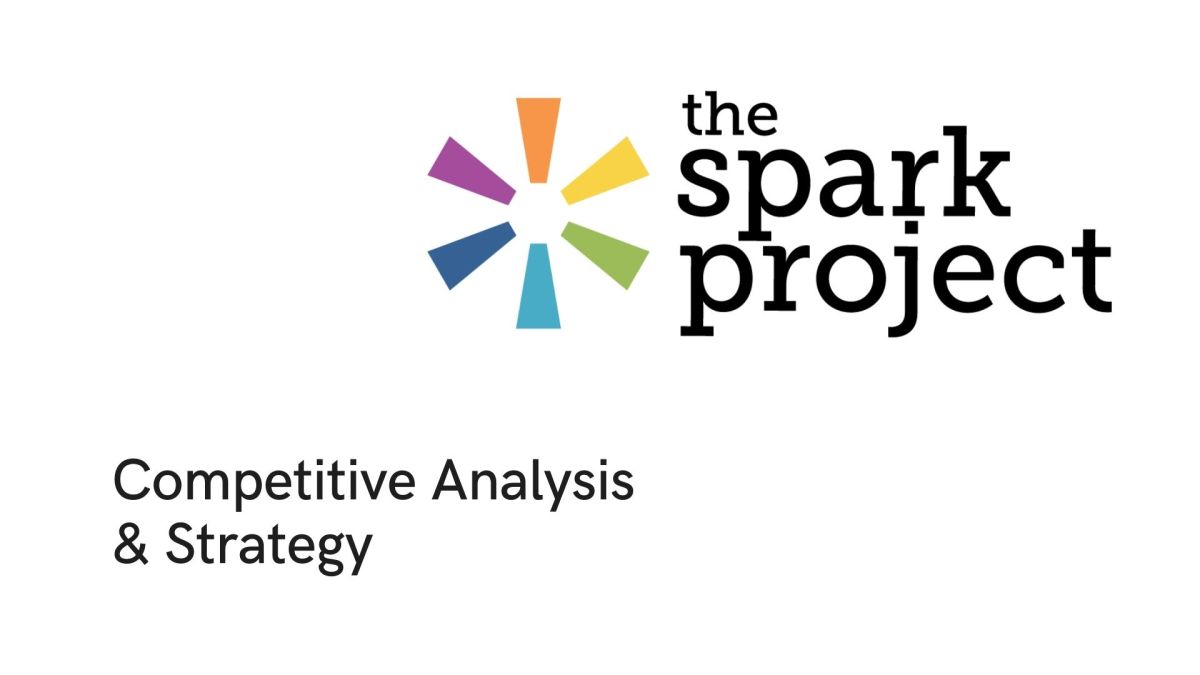
Background CROWDFUNDING 101
Crowdfunding is a novel method for funding a variety of new ventures, allowing individual founders of for-profit, cultural, or social projects to request funding from many individuals, often in return for future products or equity (Mollick, 2014). Crowdfunding provides an alternative funding strategy for entrepreneurs and organizations that typically have difficulty gaining access to traditional funding sources. Entrepreneurial success and organizational function rely on financial capacity and sustainability. Organizations need funding to maintain operations, expand services, or build up resources to develop economic resilience term (Sontag-Padilla et al, 2012). Unfortunately, social enterprises, nonprofit organizations (NPOs), and startup businesses face financial sustainability challenges because of limited funding resources (Cosh et al, 2009; Sontag-Padilla et al, 2012).
Current literature contends that crowdfunding provides these three key non-financial benefits: (1) consumer insight, (2) market exposure, and (3) a product development mechanism (Agrawal et al, 2011; Belleflame et al, 2014; Lehner et al, 2015; Mollick & Kuppuswamy, 2014). These benefits incentivize project owners to not only participate in but also, more importantly, succeed in crowdfunding (Agrawal et al, 2013).
There are four general types of crowdfunding:
There are three actors in the crowdfunding model: fund seeker, funder, and crowdfunding platform. The fund seeker, also called the project owner or crowdfunding campaigner, launches a campaign in a crowdfunding platform. The funder, also known as the donor or campaign backer, pledges funds to the campaign. The crowdfunding platforms earns revenue through fees, such as but not limited to listing fees, platform fees, and add-ons.
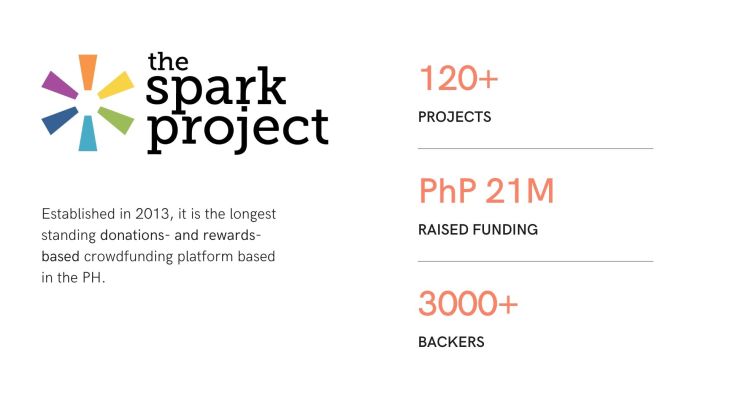
Company Profile THE SPARK PROJECT
Established in 2013, the Spark Project is the longest standing donations- and rewards-based crowdfunding platform based in the Philippines. To date, over 120 projects launched on The Spark Project, raising close to PhP21 million in funding from over 3000 backers.
They follow a keep-it-all funding model, wherein the fund seeker gets to keep all of the funding it has raised, whether or not it achieved its funding target. This is opposed to the all-or-nothing model that Kickstarter follows, wherein the fund seeker must achieve or exceed its funding target to receive the pledges.
How they define themselves
The Spark Project is a platform and community for those who see entrepreneurship differently. It’s for founders, creatives, and changemakers who are passionate about using their creative talents to build sustainable businesses. It’s for everyone who believes that making conscious choices, no matter how small, when done together can change the world.
Mission
Their mission is to promote creative consciousness by enabling entrepreneurs and changemakers, and giving them access to tools, resources, and a community that will help them transform their awesome ideas into reality.
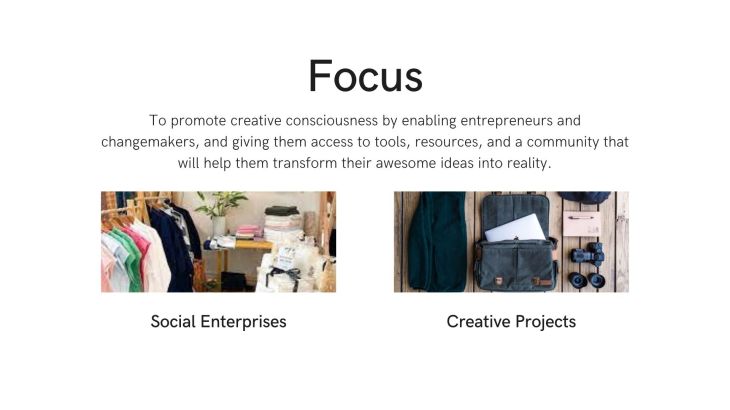
Strategic Focus
The Spark Project’s strategic focus is in helping social entrepreneurs, creative entrepreneurs, and changemakers to raise funding and to promote their products and services.
Projects at The Spark Project must be fundable through a donations-based or a rewards-based, are beyond idea stage, show creative and conscious qualities, and must fall under one or more of these categories:
The Spark Project does not allow projects that have a political or religious agenda, contain drugs and promote any illegal activity, and advance personal causes.
Supporting Sustainability
The Spark Project’s beliefs and core values include Go Slower, Closer, and Deeper and Creative Consciousness, which aligns with their mission to build sustainable businesses.
As their work involves creating and nurturing an inclusive ecosystem that supports social enterprise development, they support all 17 SDG goals.
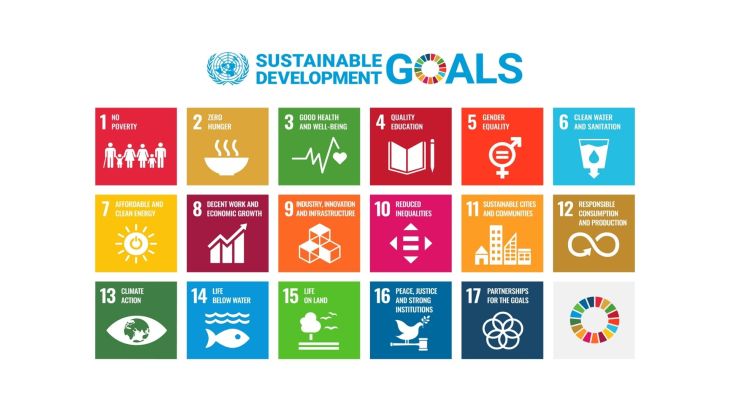
Crowdfunding Revenue Model
The Spark Project charges the following fees:
[1] Listing Fee
For both donations and rewards-based projects, the fee is P2,500. This is paid before the campaign is published.
[2] Platform Fee
Rewards-based projects: 10% of the total gross funds raised if the campaign is successful, or 15% of the total gross funds raised if the campaign is unsuccessful. This is paid at the end of the campaign.
Why charge different fees? According to them:
“We have a different fees based on the project turnout to 1) encourage project creators to estimate properly and 2) motivate the project creators to campaign passionately for their projects. We owe it to our potential backers to feature well thought of projects by passionately committed creators through the site.”
Donations-based projects: P1,500 for every month that the campaign will be running on the site. This is paid along with the Setup Fee before the campaign can be published.
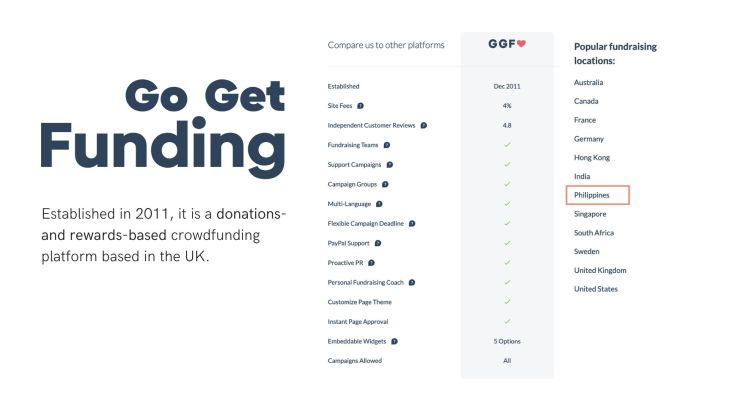
Competitor Profile GO GET FUNDING
Established in 2011, it is a donations- and rewards-based crowdfunding platform based in the UK that labels itself as the #1 crowdfunding platform for personal causes.
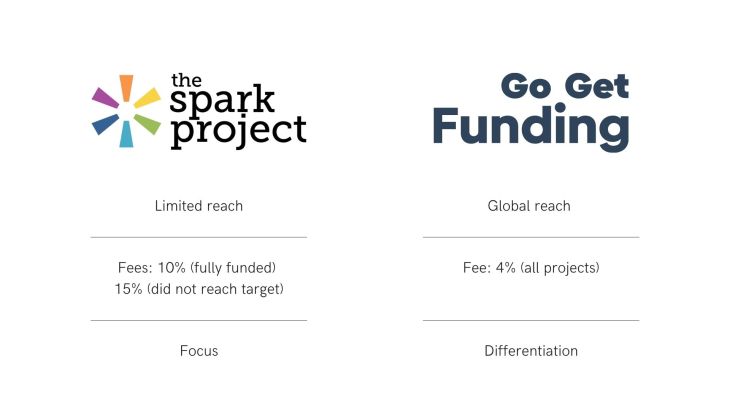
Strategic Positioning: Differentiation
It claims to provide the superior product over the top global crowdfunding platforms. It has a global reach, and anyone in the world can put up a crowdfunding campaign on the website. It offers the greatest number of features for fund seekers, including fundraising coaches.
Revenue Model
Transaction fee of 6.9%, comprised of 4% platform fee and 2.9% payment processing fee. There is a 0.30c handling fee for each donation made.
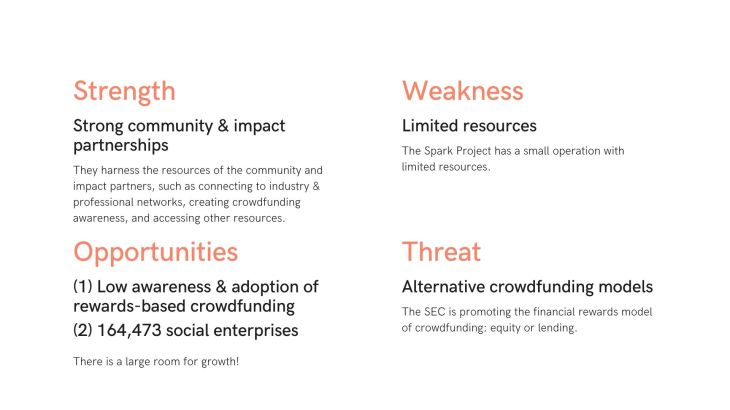
SWOT ANALYSIS The Spark Project
Strength A leader in social enterprise development and ecosystem building through nurturing strong relationships with community and impact partners.
“It started with crowdfunding. But over the past decade, we’ve grown into becoming a leader in social enterprise development and ecosystem building. Serving many aspiring and emerging founders who are eager to purposefully grow their business. As a funding and founder development platform, we’ve supported thousands of entrepreneurs and changemakers, and worked with top ecosystem enablers in the Philippines and across South East Asia.”
They harness the resources of the community and impact partners, such as connecting with industry & professional networks, creating crowdfunding awareness, and accessing other resources. Their community is a community of supporters, which include Spark Alumni and industry partners, that support both The Spark Project and Spark Project fund seekers.
It is through this community that the platform can offer mentoring and coaching to current fund seekers. This community provides the resources that allow the platform to offer free training and workshops for potential fund seekers.
Weakness Limited resources
Unlike its global competitors, The Spark Project has a small operation with limited resources. Awareness about The Spark Project is low because of the lack of traditional funding for marketing.
Opportunity There is room for growth!
There is low awareness and adoption for crowdfunding, particularly in the segment that The Spark Project wants to cater to: Philippine-based social enterprises and micro/small creative businesses (Doce et al, 2021; Vergara, 2015).
However, this means that there is opportunity to grow the market. According to one estimate, there may be as many as 164,473 social enterprises in the Philippines, constituting 17% of the 987,974 registered companies. Of these social enterprises, 70% operate as micro, small, and medium-sized enterprises (MSMEs), 23% as nongovernment organizations, and 6% as cooperatives. These figures are based on a definition of social enterprises that includes financially unsustainable entities. Most social enterprises remain limited in size and scale due to critical gaps in (i) access to capital, (ii) innovative financial mechanisms to unlock additional capital, (iii) ecosystem knowledge of social enterprises, and (iv) data on social enterprise impact. (Ito & Shahnaz, 2019)
Threats Alternative Funding Models
Financial-return crowdfunding, equity- and lending-based, provide alternative crowdfunding avenues for small businesses. The Philippine SEC is openly promoting crowdfunding to SMEs as alternative funding sources.
Platforms that use financial return crowdfunding model are regulated by the Philippine Securities and Exchange Commission. The Spark Project does not use a financial return model.
Source: SEC Memorandum Circular No. 14 Rules and Regulations Governing Crowdfunding
KEY DRIVERS Philippine Crowdfunding Industry
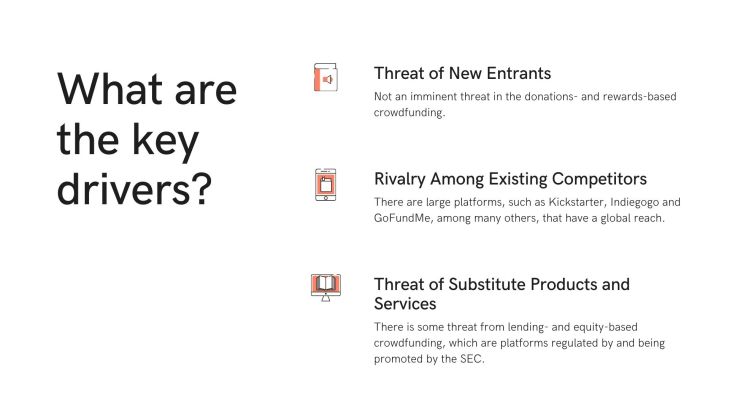
Threats of substitute products and services
There is some threat from PH-based lending- and equity-based crowdfunding, which are platforms regulated by and being promoted by the Philippine SEC as alternative funding sources for SMEs.
There is also threat to alternative crowdfunding platforms, such as Patreon, that caters specifically to artists and creators.
Threat of new entrants
There is no imminent threat in the donations- and rewards-based crowdfunding platform space. Other PH-based crowdfunding platforms have stopped operating due to low crowdfunding awareness and adoption.
This low awareness and adoption is seen by previous players as a high barrier for entry as there is a need to educate the market, specifically make them understand the challenges of launching and sustaining a successful crowdfunding campaign.
Rivalry among existing competitors
There are large platforms, such as Kickstarter, Indiegogo, GoGetFunding, and GoFundMe, among many others, that have a global reach and actively competing in the global market. These platforms remain top of mind for Filipinos who are aware of crowdfunding.
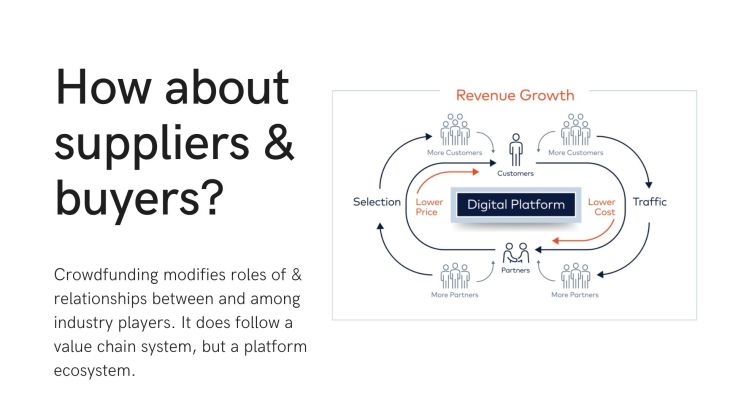
Bargaining power of suppliers and bargaining power of buyers
The crowdfunding impact is not limited to funding but also has overarching effects across the entire value chain, and it modifies the relationships between industry stakeholders (Nucciarelli et al, 2017). Crowdfunding modifies roles of & relationships between and among industry players. It does follow a value chain system, but a platform ecosystem. What this means is that it pays for any player in the crowdfunding space to increase the size of the ecosystem as this benefits all players, regardless of their relationship or whether they are in rivalry.
Also, within the ecosystem, players may take on different roles. Crowdfunding platform owners may themselves become fund seekers or funders. Fund seekers may back or pledge in other crowdfunding campaigns, and funders may become fund seekers, too. This is evidenced by the experience of The Spark Project and its community (Vergara, 2015).
TOP CHALLENGES What is the problem?
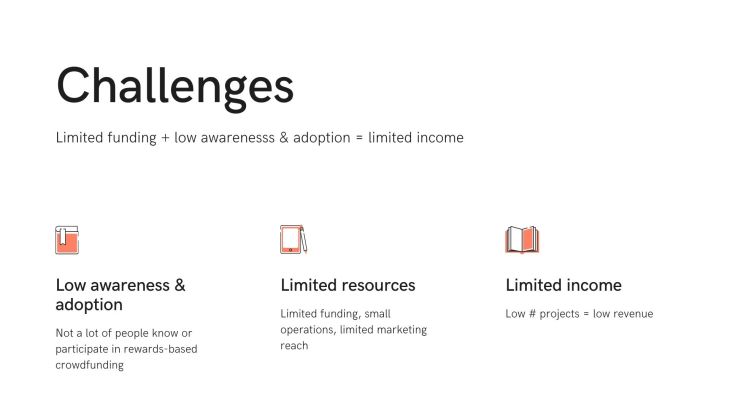
VICIOUS CYCLE: Limited funding + low awareness & adoption = limited income
The biggest challenge of any PH-based crowdfunding platform is escaping the vicious cycle of limited funding, low awareness and low adoption, which all leads to low income. The reason why previous players, such as Artiste Connect, folded is because they were unable to escape this vicious cycle.
STRATEGIC DIRECTION What is the solution?
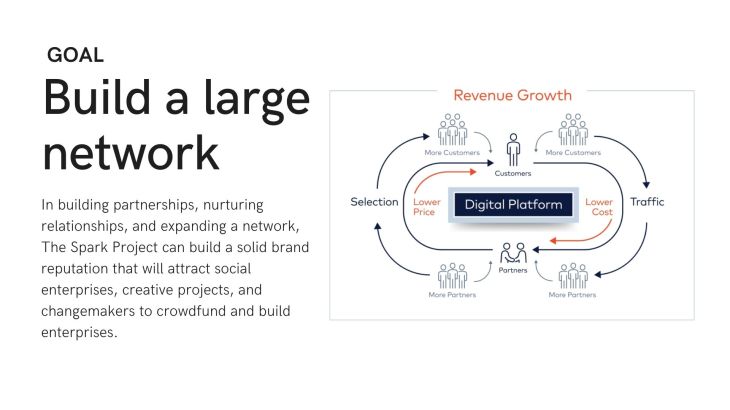
Build a larger network or ecosystem
In building partnerships, nurturing relationships, and expanding a network, The Spark Project can build a solid brand reputation that will attract social enterprises, creative projects, and changemakers to not only launch crowdfunding campaigns but also use the platform to build their enterprise.
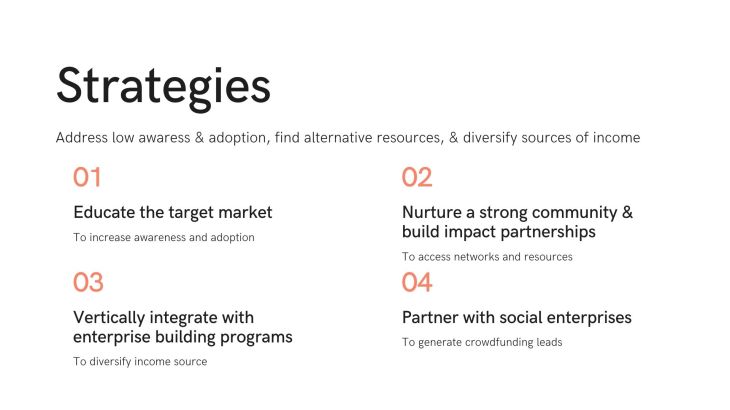
STRATEGIES
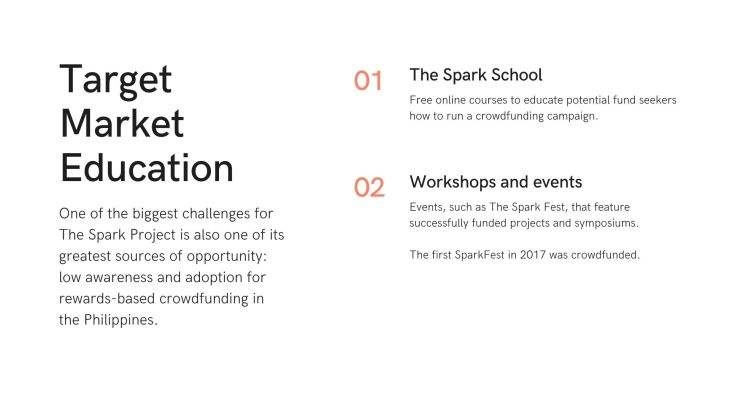
(1) Educate the target market
Why do this? To increase crowdfunding awareness and adoption
One of the biggest challenges for The Spark Project is also one of its greatest sources of opportunity: low awareness and adoption for rewards-based crowdfunding in the Philippines.
Through workshops and events, The Spark Project is helping educate the market about crowdfunding, if a little slowly given its limited funding.
The Spark School https://school.thesparkproject.com/
The Spark School is a learning hub for social entrepreneurs. It offers free online courses to educate potential fund seekers how to run a crowdfunding campaign and to help social entrepreneurs gain access to knowledge of experts, leaders, and fellow entrepreneurs across different industries.
Workshops and Events
Events, such as The Spark Fest, that feature successfully funded projects and symposiums. The first SparkFest in 2017 was crowdfunded.
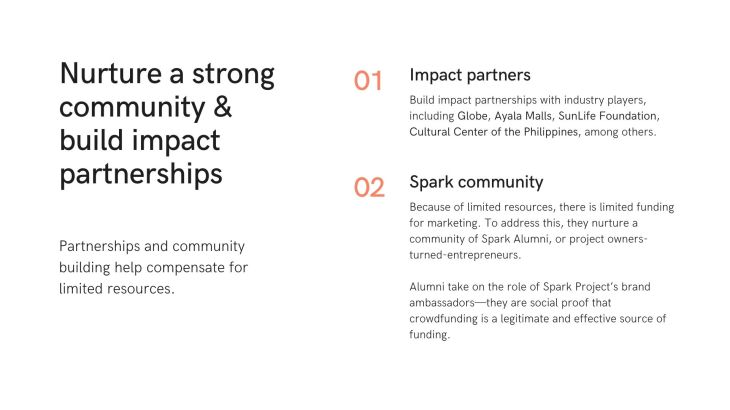
(2) Strengthen community relationships and impact partnerships
Why do this? To access networks and resources Partnerships and community building help compensate for limited resources. The Spark Project addresses their challenges with limited funding through building and nurturing impact partnerships with industry players, including Globe, Ayala Malls, SunLife Foundation, Cultural Center of the Philippines, among others. These partnerships lead to access to more resources that benefit not just The Spark Project but also their immediate customers: social and creative entrepreneurs.
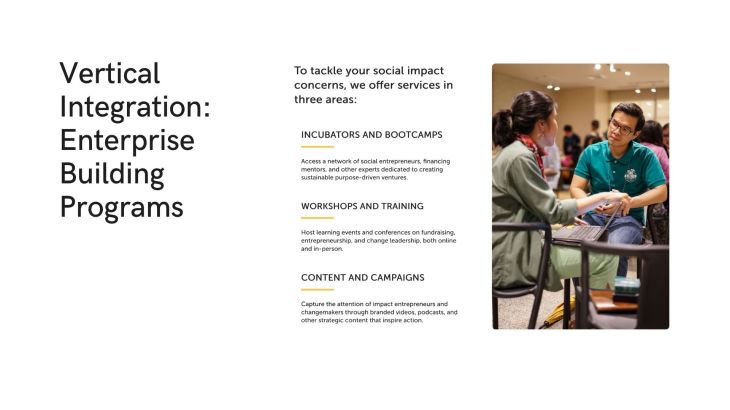
(3) Vertical integration through Enterprise Building Programs
Why do this? To diversify and increase revenue
The Spark Project continues to support their project owners long after their crowdfunding campaigns have concluded. They have ventured into enterprise development through incubator programs, matching with grants and funding, and access to small business support services. The Spark Project generates more revenue from these enterprise building programs and consultancies than they do from crowdfunding campaigns. This allows them to not only continue operating as a crowdfunding platform but to also provide significant impact as a social enterprise building platform.
Accelerator Programs and Impact Labs
The Spark Her Enterprise (SHE) Accelerator is a program for women entrepreneurs organized by The Spark Project in partnership with the Sasakawa Peace Foundation. The aim of this program is help these micro and small enterprises sustain and grow their businesses.
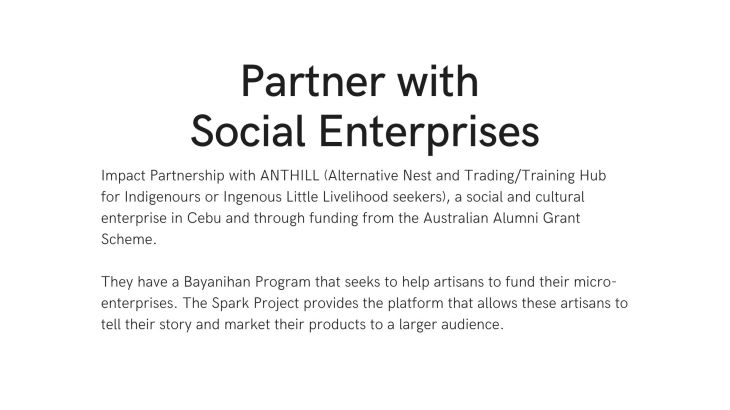
(4) Partner with social enterprises
Why do this? To generate crowdfunding leads
What was previously lacking was a leads generation strategy, such as partnerships with networks of potential customers, specifically social enterprises and creative micro-entrepreneurs.
They have recently started a partnership with ANTHILL (Alternative Nest and Trading/Training Hub for Indigenours or Ingenous Little Livelihood seekers), a social and cultural enterprise in Cebu and through funding from the Australian Alumni Grant Scheme. They have a Bayanihan Program that seeks to help artisans to fund their micro-enterprises. The Spark Project provides the platform that allows these artisans to tell their story and market their products to a larger audience.
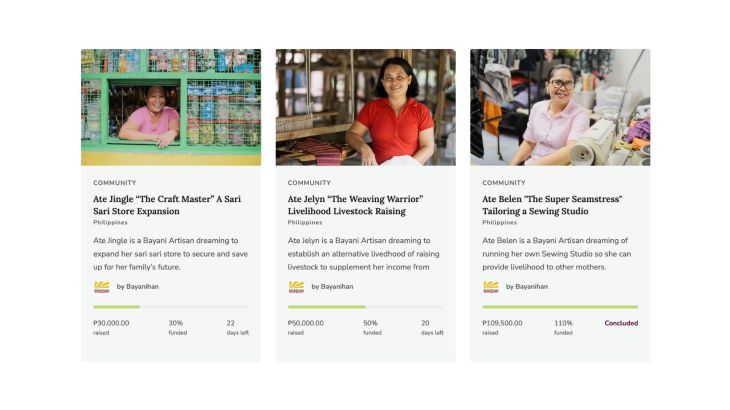
REFERENCES
Agrawal, A. K., Catalini, C., & Goldfarb, A. (2011). The geography of crowdfunding (No. w16820). National bureau of economic research. https://doi.org/ 10.1086/674021
Belleflamme, P., Lambert, T., & Schwienbacher, A. (2014). Crowdfunding: Tapping the right crowd. Journal of business venturing, 29(5), 585-609. https://doi.org/10.1016/j.jbusvent.2013.07.003
Cosh, A., Cumming, D., & Hughes, A. (2009). Outside enterpreneurial capital. The Economic Journal, 119(540), 1494-1533.
Doce, L. J., & Ching, M. R. (2021). Perceptions to Crowdfunding Adoption in Philippines: A Study on MSMEs. In PACIS (p. 141).
Ito, Y., & Shahnaz, D. (2019). Road map for strengthening social entrepreneurship in the Philippines. Retrieved from https://www.adb.org/sites/default/files/publication/514471/adb-brief-112-social-entrepreneurship-road-map-philippines.pdf
Lehner, O. M., Grabmann, E., & Ennsgraber, C. (2015). Entrepreneurial implications of crowdfunding as alternative funding source for innovations. Venture Capital, 17(1-2), 171-189. https://doi.org/10.1080/13691066.2015.1037132
Mollick, E. (2014). The dynamics of crowdfunding: An exploratory study. Journal of business venturing, 29(1), 1-16. https://doi.org/10.1016/j.jbusvent.2013.06.005
Mollick, E. R., & Kuppuswamy, V. (2014). After the campaign: Outcomes of crowdfunding. UNC Kenan-Flagler Research Paper, (2376997).
Sontag-Padilla, L.M., Staplefoote, L., & Gonzalez Morganti, K. 2012. Financial sustainability for nonprofit organizations: A review of the literature. Santa Monica, CA: Rand Corporation. Retrieved from http://www.rand.org/pubs/research_reports/RR121.html
Nucciarelli, Li, F., Fernandes, K. J., Goumagias, N., Cabras, I., Devlin, S., Kudenko, D., & Cowling, P. (2017). From value chains to technological platforms: The effects of crowdfunding in the digital game industry. Journal of Business Research, 78, 341–352. https://doi.org/10.1016/j.jbusres.2016.12.030
Vergara, R. (2015, February). Awareness and attitudes towards crowdfunding in the Philippines. In 9th Global Business Conference (Vol. 1, pp. 3-5).
Tales from the classroom is a special blog series where I share research and articles I produce in my DBA (Doctorate in Business Administration) program.

How do you take your coffee?
The Starbucks experience takes a simple, common, everyday question into a uniquely personal and sensorial experience. In this ad, I see two messages that Starbucks wants to convey. First, Starbucks gives the customer the control over how their cup is prepared. Second, each coffee is tailor-made to suit the customer’s taste and preference.
As a busy mom of three, this is a welcome message. My days look different from each other—and they are rarely how I planned them to be. It is easy for me to lose control of my day. Because I work from home, I take on the role of the primary parent who will adjust my schedule should something come up—and something always comes up!
Someone needs to be picked up earlier than scheduled? Nanay drops everything and drives to school. Someone is sick and needs to be brought to the clinic? Nanay will call the clinic and set up an appointment. Someone needs help with homework or a school project? Nanay will remember which materials to buy and help the kids finish. Tatay needs to be picked up from the bus stop after a long day at work? Nanay will do it!
My days are spent in service of others. And not just my family—my clients, too. Client needs a report or survey questionnaire sent in ASAP? Kim will get things going to send that report. Client needs resources for a project? Kim will get the team together to brainstorm and delegate tasks.
I am there to make sure that things are managed and under control. I am there to make my family feel special. I am there to make sure that my clients have what they need to succeed. I do things for others because I love my family and I want success for my clients. They are special to me.
But, how about me?
Starbucks is here to give me a choice—control over how I want things done. Starbucks also offers to make something for me—it’s coffee made for me, the way I want it, and without me needing to lift a finger except to pick it up from the counter and drink from my cup. I don’t need to drop anything or work around my schedule. I don’t need to make compromises. Starbucks will make something special just for me. It’s a small treat to reward myself for doing a lot and to fuel me for a busy day.
When I see ads, my first instinct is to decipher what the message it is trying to convey so that I get an insight on who is meant to receive the message. The message typically describes or implies characteristics of specific consumer behavior.

For this Starbucks ad, I noticed the reference on hands—from the photo of the hand, the hand drawn doodles, and the handwritten “Enjoy.” It conveys that each cup is handmade. It’s a special cup because it is made for one person in mind.
This leads me to believe that this message is meant for people who appreciate things that are tailor-made for them, even if it costs a little bit more.
Which buyer persona fits this behavior? This is for the mass affluent who can afford a PhP200+ custom-made coffee. And because coffee is a perk-me-up product that is meant to be enjoyed, I also infer from the messaging that Starbucks positions itself to busy individuals who just have enough time to enjoy a cup of hand-crafted, specially made coffee.
And that’s me! I consider myself the target market of Starbucks. It’s a perk-me-up drink that is meant to fuel a busy work-from-home mom (me!) who wants some time for herself and a treat specially made for her to enjoy while having special me-time to get her through the day.
Tales from the classroom is a special blog series where I share research and articles I produce in my DBA (Doctorate in Business Administration) program.

As a market researcher, I help small businesses understand their target market to achieve varying business goals. Currently, I am working with a client who wants to disrupt the renter’s market in the United States by introducing a new service: allowing renters to pay rent through their credit cards.
The service itself is not entirely new, but its usage has yet to reach mainstream and there is a very small competition pool. Currently, there are existing platforms that allow people to pay rent through their credit cards. Some platforms are marketed directly to renters, while many others are marketed as a platform that allows you to pay different services using a credit card. Despite the high credit card usage rate in the United States and progress in financial technology, most renters still pay using cash or bank transfers. All of this leads him to believe that there is untapped potential in the market. What the client wants is to improve the rent payment market by offering renters better payments options.
There are advantages to paying rent through a credit card. For one, it affords renters a grace period—rent is technically paid when the credit card is due. Furthermore, many credit card products offer perks and privileges, such as cashbacks, travel miles, rewards points, insurance, etc. The disadvantage of using a credit card is a 2.9% transaction fee. That said, people who perceive value in the service will typically be willing to pay for the service in exchange for the value they receive and enjoy.
He approached me with two questions: How do I sell this service to the renter’s market? Who in the market will buy this service? To help the client achieve his startup’s goals, I reframed the question: Why will people subscribe to this service? To answer this question is to understand consumer behavior, specifically customer trends and preferences.
I recommended that we investigate consumer behavior related to paying rent, specifically the following information: (1) what payment method or methods renters typically use to pay rent, (2) why they chose to pay rent this way, and (3) what pain points they experience when they use their current rent payment method. The research also aims to understand demographic details, such as income, average rent paid, how long they have been renting, and their current location, to help us segment the market and figure out the right pricing scheme.
The client has assumptions about renter payment behavior and why the market has yet to embrace paying rent through a credit card. In understanding customer trends and preferences, the client can confirm or debunk his assumptions about the market and their rent paying values. Most importantly, in understanding the three salient points stated above, the client will know who his target market is and what they value. This will help him achieve two things.
First, it will help him understand how to develop a product that the target market wants. Product development is a feasible marketing strategy particularly at this early stage. Knowing who the market is will help him identify which features to offer and, as a corollary, which partners to work with so that he can offer the features that the target market wants to see and use. This will help ensure that he offers a service that addresses the customer’s pain points and aligns with their consumption values.
Second, the consumer information will also help him craft an integrated marketing campaign that will communicate the service’s value to the target market. Because this is a relatively new service, one of the primary marketing communication thrusts would be educating the market about the benefits of using the new service. In the early stages of the launch, it is important to communicate how the service addresses the target market’s pain points and aligns with their values.
Tales from the classroom is a special blog series where I share research and articles I produce in my DBA (Doctorate in Business Administration) program.